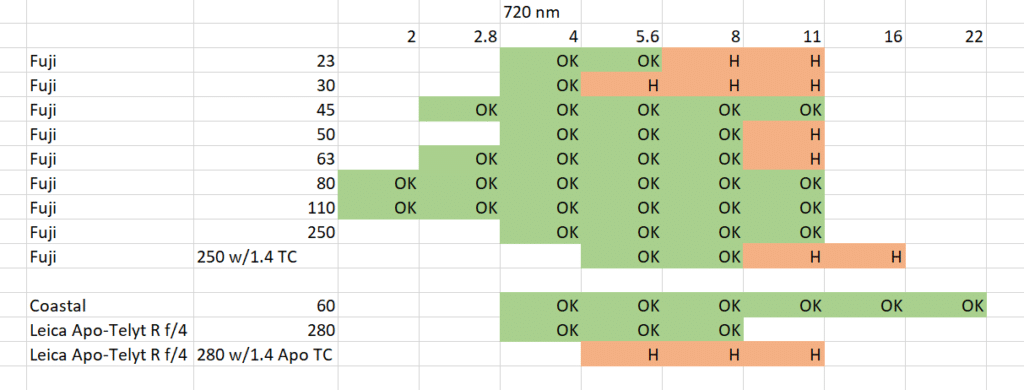I keep being asked which Fuji GF lenses hotspot and which don’t. I tested on a GFX 50R modified by LifePixel to respond to wavelengths longer than 720 nm. Here’s a table I made from the results:
OK means no hotspotting, or very little. H means hotspotting that I consider to be unacceptable. I threw the Coastal Optical 60 mm f/4 UV-VIS-IR into the mix. All lenses were tested with subjects tens of meters away. The second row is the f-stop.

Thanks for compiling this chart Jim! I can add that at 850nm the 120 has the same level of excellent hotspot performance as the 45 and 250. If there is a specific test you are doing, let me know and I can send you a few samples for evaluation.
Jim:
Could you define what you mean by hotspotting.
https://kolarivision.com/the-science-of-infrared-hotspots/
Have you considered a more technical approach to quantifying hotspot tests? I find trying to shoot into foliage or a wall like many do to be a pretty poor method- you really need a strong Ir source in bottom frame and then something empty and clear in the middle- like clear sky in order to see more subtle contrast issues.
Or to quantify it this is the best testing method anyone has come up with as a system so far: https://www.edwardnoble.com/hotspot-info
https://www.edwardnoble.com/hotspots
I have replicated this test myself with a similar lamp and testing scale since I can’t trust any other hotspot lists or people.
I’ve lost count of how many times some list or person has sworn lenses don’t have hotspots only to buy them and find they’re terrible (the lifepixel list, kolari list, countless blogs and forums). It seems few really knows how to stress test lenses and find the more subtle hotspot issues, but they can ruin photos.
I would be interested in moving to Fuji for IR, but lenses do not seem promising. It’s also interesting that fuji releases an IR GFX camera, but doesn’t look like they have put any special thought into IR lens performance for it.
My testing shows that the both the Fuji 45-100 and 100-200 Zooms perform well (no hot spots) in with 680 and 720 nm IR filtration on the 50S. Unfortunately the 32-64 Zoom does not do so well beyond f/8. The 100-200 Zoom is also good with 850 and 950nm filtrationPhil
Thank you for the thumbs up on the GF 100-200. Can’t wait to use it on my soon to be converted GFX 50R.
Hi Jim,
Just curious if you have had time to test the GF 80 on your IR converted camera yet?
I haven’t tried it, but I will.
Thanks in advance. I am hopeful that it will be a good performer in IR.
Tested. It works fine. There is some measurable hotspotting, but nothing that would be objectionable unless you’re really pushing it. I’ve updated the table.
That’s good news! Thanks for testing!
How confident are you that the GF 45-100 performing well?
I just acquired the 45-100, and am considering selling my 45 mm prime since I have the new lens.
Thanks
My copy appears to be excellent.
Has anyone tried the GF35-70mm in IR?
Hi Jim,
To add the 500mm has no hotspot even at f/22, I did not bother to test further.
The 55/1.7 has a very visible hotspot from f/2.8 onwards, bad candidate for IR.
Cheers